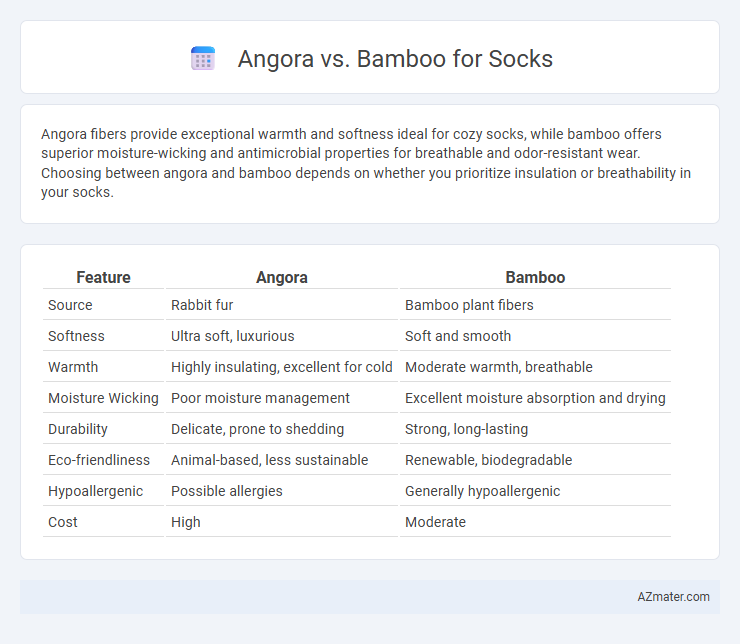Angora fibers provide exceptional warmth and softness ideal for cozy socks, while bamboo offers superior moisture-wicking and antimicrobial properties for breathable and odor-resistant wear. Choosing between angora and bamboo depends on whether you prioritize insulation or breathability in your socks.
Table of Comparison
| Feature | Angora | Bamboo |
|---|---|---|
| Source | Rabbit fur | Bamboo plant fibers |
| Softness | Ultra soft, luxurious | Soft and smooth |
| Warmth | Highly insulating, excellent for cold | Moderate warmth, breathable |
| Moisture Wicking | Poor moisture management | Excellent moisture absorption and drying |
| Durability | Delicate, prone to shedding | Strong, long-lasting |
| Eco-friendliness | Animal-based, less sustainable | Renewable, biodegradable |
| Hypoallergenic | Possible allergies | Generally hypoallergenic |
| Cost | High | Moderate |
Introduction to Angora and Bamboo Socks
Angora socks, crafted from soft fibers of the Angora rabbit, provide exceptional warmth and luxurious softness, making them ideal for cold weather. Bamboo socks, made from bamboo pulp, offer natural moisture-wicking, breathability, and antimicrobial properties, ensuring comfort and odor resistance for everyday wear. Both materials combine unique benefits, with Angora excelling in insulation and Bamboo emphasizing sustainability and hygiene.
Material Origins and Production
Angora fibers are derived from the Angora rabbit, primarily farmed in regions such as China and France, where the soft undercoat is gently plucked or sheared to ensure animal welfare. Bamboo fabric for socks is produced from bamboo grass, predominantly cultivated in China and Southeast Asia, where the raw bamboo is mechanically or chemically processed into viscose or rayon fibers. The natural origin of Angora provides exceptional warmth and softness, while bamboo offers breathable, moisture-wicking, and eco-friendly properties due to its sustainable cultivation and biodegradability.
Softness and Comfort Comparison
Angora fibers are renowned for their exceptional softness due to their fine diameter and hollow core, providing superior insulation and a fluffy texture ideal for cozy socks. Bamboo fabric offers a silky smooth feel and excellent moisture-wicking properties, enhancing comfort through breathability and natural antibacterial qualities. Choosing between Angora and Bamboo socks depends on whether warmth and plush softness or lightweight, breathable comfort is the priority.
Warmth and Breathability Differences
Angora wool provides exceptional warmth due to its fine, insulating fibers that trap heat effectively, making it ideal for cold weather socks. Bamboo fabric, known for its natural moisture-wicking properties, enhances breathability and keeps feet dry by allowing better air circulation. Combining Angora's thermal insulation with Bamboo's ventilation offers a balanced sock option for both warmth and comfort.
Moisture-Wicking Properties
Angora fibers are known for their excellent insulation and softness but have moderate moisture-wicking abilities, making them less effective in keeping feet dry during intense activities. Bamboo fabric excels in moisture-wicking due to its natural breathability and ability to absorb and evaporate sweat quickly, providing superior comfort for socks in warm or active conditions. Combining bamboo with Angora can balance warmth and moisture management, enhancing overall sock performance.
Durability and Longevity
Angora fibers, derived from Angora rabbits, provide exceptional warmth and softness but tend to be less durable and may pill quickly, reducing the longevity of socks. Bamboo socks offer superior durability due to bamboo fiber's natural strength and antifungal properties, making them resistant to wear and moisture over time. For long-lasting socks that maintain their shape and comfort, bamboo is generally the more durable option compared to Angora.
Hypoallergenic and Skin-Friendliness
Angora socks are known for their natural warmth and softness but may cause allergic reactions in sensitive individuals due to the lanolin content in the fur. Bamboo socks offer superior hypoallergenic properties, containing natural antimicrobial agents that reduce the risk of skin irritation and fungal infections, making them ideal for sensitive or allergy-prone skin. Bamboo fibers also provide excellent moisture-wicking and breathability, enhancing overall skin comfort during prolonged wear.
Eco-Friendliness and Sustainability
Angora socks, made from soft, renewable rabbit fiber, offer excellent warmth but raise concerns about animal welfare and ethical sourcing, impacting their eco-friendliness. Bamboo socks provide a highly sustainable option due to bamboo's rapid growth, minimal water usage, and natural antimicrobial properties, making them biodegradable and eco-friendly. Choosing bamboo socks supports reduced environmental impact and promotes sustainable textile production over animal-derived fibers.
Care and Maintenance Requirements
Angora socks require gentle hand washing with cool water and mild detergent to maintain their softness and prevent fiber damage, while bamboo socks are more durable and can often be machine washed on a delicate cycle without losing shape or comfort. Both fibers benefit from air drying to avoid shrinkage and maintain elasticity, but angora is particularly sensitive to heat and agitation, which can cause matting or felting. Proper care extends the lifespan of Angora and Bamboo socks, preserving their natural temperature regulation and moisture-wicking properties.
Choosing the Best Socks: Angora vs Bamboo
Choosing the best socks depends on your priorities for comfort and sustainability, with Angora socks offering unmatched softness and natural warmth due to the fine fibers from Angora rabbits. Bamboo socks provide excellent moisture-wicking and breathability, making them ideal for odor control and eco-friendly wear, as bamboo is a highly renewable resource. For durability and heat retention, Angora excels, while bamboo is preferable for hypoallergenic properties and temperature regulation in varied climates.

Infographic: Angora vs Bamboo for Sock
 azmater.com
azmater.com